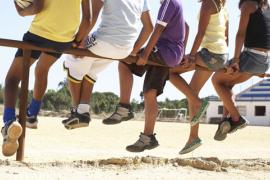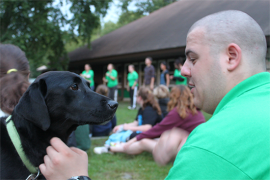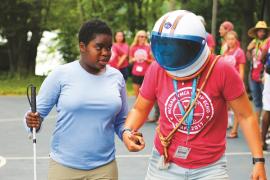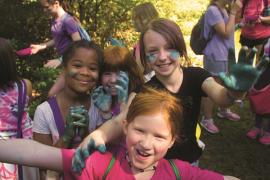The sound of sleet pelting off my rain jacket as Jordan put it on was quite a surprise. Jordan is a 16-year-old, boarding school student I’ve had a mentoring relationship with for five years. An intense gust of wind almost blew my yellow, flat brimmed hat out of my hand as I replaced it with the much-needed warmth of my gray beanie. The sudden chill in the air was shocking, and we gasped for breath from its bite. It was all a bit unexpected for a sunny Saturday afternoon adventure to the Atlantic Coast in New England.
The storm rolling in off the water displayed dark clouds and a sheet of rain moving in our direction. As I added another layer from the back of my car, a green, insulated vest, I caught a glimpse of the uneasiness in the moment through Jordan’s glasses.
Moments before, we’d sat in the warmth of the car, questioning how the day had shifted and what choice we would make next. I saw a bit of apathy and sensed a disconnect from Jordan I wasn’t accustomed to. The vastness of his blank stare concerned me. We had planned this day for weeks. It was part of our monthly rhythm to get time together and learn from each other. We were set to walk on the beach (his second time) and to catch up on what had been happening in his most recent school semester and new areas of my work.
“I guess with the weather we can’t do this today?” Jordan inquired.
“I think that’s up to us,” I responded.
We sat silently for 10 minutes, saying a lot more to each other than we knew. I broke the silence and said, “I need to walk, and there’s no lightning or thunder. I’m going for it. And I understand if you want to stay here.”
Jordan quickly said, “I don’t think I’m going to join.”
I stepped out of my car and crouched down between my two doors, hiding from the swirling wind and gusts of wetness as I tried to add some layers. As I stood up, shivering in front of me, Jordan asked, “Do you have anything I can wear?”
Once we were as equipped as we could be for the journey ahead, we walked to the end of the beach, past the lighthouse on the bluff, and following Jordan’s lead and prompting, we kept walking out onto a granite pier of large rocks jutting a couple hundred yards out into the water. We were on a collision course with the elements. It didn’t take long for the sheet of rain and dark clouds to meet us and prohibit us from conversing.
As we reached the end of the point, we stood looking out across the ocean, feeling the wind gusts pound on our faces as the waves crashed on the rocks where our feet found footing. We looked at each other, water running down our cheeks and dripping off our noses, and found smiles and warmth creeping onto each other’s faces.
Our jackets and clothes squished as we sat back down in the car. “Well?” I asked.
Finally the words we both needed to hear came out of Jordan’s mouth.
“It feels so good to feel something! I needed to feel something because I’ve felt alone.”
I was stunned. The truth of Jordan’s words was powerful, and my mind flooded for a moment. Do I comfort him? Do I commend him for sharing so bravely? How can I best use my mental, emotional, and social health (MESH) tools to connect in a meaningful way?
Finally the truth came out. “Yes, Jordan, I couldn’t agree more. It feels so good to feel something. And I have been struggling too.”
We were both in tears. He was floored. “You mean I’m not alone in this feeling?”
I smiled, “No, I am with you.”
The moment was poignant. As a mentor and leader, it was one I will hold onto for quite some time.
To many people, it seems that individuals from Generation Z (those born between 1996 and 2010) are just trying to tear everything down. But to Zs, the issues we all face are beyond politeness, so they are not asking politely. They’re not quiet or meek. They are demanding. They are assertive and bold. Many older Americans aren’t sure what to make of the rapid rise of Generation Z, from the school gates in Parkland to the steps of the US Capitol. Zs are outspoken, persistent, and happy to use unconventional tactics to disrupt the status quo. That makes people uncomfortable. No one knows where Zs are going to show up or what they’re going to do. They’re unpredictable. And we’ve long celebrated a predictable way of living (Hayek, 2021).
As leaders interacting with the next generation we have a choice. We can spin our wheels trying to understand why they aren’t where we are, where we believe they “should be,” or we can consider the uniqueness of the moment we are all living through and sense the necessary shift to foster a feeling in all the areas of our work. Our ability to foster the feelings from within is the greatest attribute in working toward sensing someone else’s emotions.
Honing our familiarity with our five senses is an essential part of leadership in a time where seven generations — Greatest, Silent, Boomers, X, Millennials, Z, and Alpha — are navigating this space and seeking reliable pathways of connection with others. We must discern the difference between proprioception, our bodies’ true sense of presence in relation to others in a space in time, and interoception, the mind’s ability to be awakened to the instincts of our own internal processing of the emotions that will become feelings (Clifford, 2018).
In my career, I’ve been fortunate to navigate leadership transitions with three business founders. Each was a powerful leader, entrepreneur, and visionary. My leadership temperament is one driven by emotional intelligence and empathy. At a critical time of transition in what they had uniquely birthed, they each had to join me or allow me to join them on the seesaw ride of change and loss. At pivotal moments, similar to the adventure Jordan and I were on, we would have to make a choice, one in which we could hear the others’ points and learn from their perspective. We had to learn, engage, adapt, and discern (LEAD) one another and understand the moment to foster a genuine feeling in order to hear and be heard. This requires more than just listening or the longing to be heard. It demands authentic sensing.
I believe something powerful happens when we foster a feeling for others we are in charge of as we allow space for ourselves to learn, engage, adapt, and discern — LEAD — our connection to another.
Our efforts to engage with a younger generation require us to have the ability to lean into an experience beyond our comfort zone. A younger generation may seek to agitate a situation as their means of addressing their internal emotion. Being able to engage in this way merits an approach where all sides must consider how to adapt their plans and discern collective intent.
Technology, diversity, climate change — the advances and challenges we’ve encountered have impacted all generations. For Gen Z it has molded them to be activists, inclusivists, and optimists. They were born in extraordinary times, and they have a voice and a force that’s united, unprecedented, and one we must acknowledge (Hayek, 2021).
It is essential to understand how past experiences play a role in the impact on our current lives and decisions. But there is also great value in identifying how hope plays a role in guiding us through adventure across generations and enables us to plan with discernment while examining the feelings we have regarding our shared future. Hope is the belief that our future can be brighter than our past and that we have a role to play in making it so (Gwinn & Hellman, 2018). We all need to participate in a more hope-filled future.
I struggled to open up to Jordan about the personal and professional challenges I was facing. I had been led to believe our relationship was one where he needed someone who could guide, ask intentional questions, and share wisdom from experience (all great things). Yet the lesson the three founders and I cherished most was our ability to lead each other.
Jordan has since conveyed that my ability to follow his lead into a moment of honest vulnerability was one of the most impactful moments in our relationship. My invitation to you is to colead, codesign, and cowrite the future of our work with one another while we all foster what lies within.
NOTE: This article describes a formal, one-on-one, long-term mentorship program with guardian approval. It is important to note that in the camp setting, the "rule of three" is the rule of thumb, meaning people under the age of 18 should always be in the presence of at least two people at any given time.
References
Clifford, A. M. (2018). Your guide to forest bathing: Experience the healing power of nature. Newburyport, MA: Red Wheel Books.
Gwinn, C. & Hellman, C. M. (2018). Hope rising: How the science of hope can change your life. New York, NY: Morgan James.
Hayek, A. (2021). Generation we: The power and promise of Gen Z. Austin, TX: Lioncrest Publishing.
John Hamilton, MA, is the chief strategy officer for the Alliance for Camp Health (ACH) and ACA’s subject matter expert on trauma-informed care at camp. Prior to joining ACH leadership, he served as the national director for Camp HOPE America, where he collaborated with city/county government, national leaders, clinicians, psychologists, and community-based organizations. John is also a former executive director of a camp near Lake Tahoe.




